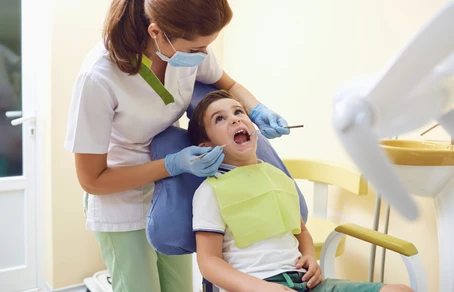How to Make Your Child’s First Dental Visit a Positive Experience

How To Make Sure Your Child Remembers Their First Dentist Visit Positively
No parent enjoys the thought of the child's first visit to the dentist. There is always the anxiety that is accompanied by that visit, especially for the children. The strange lights, along with the weird sounds, would be reason enough for anxiety. The good thing is that, with proper planning, a visit to the dentist can be a positive experience, rather than a dreaded one. If children learn to associate visits to the dentist positively, it will be beneficial for them to develop good dental habits in the future.
The parent must understand that a positive first visit will surely be a positive one for the other visits as well. Those parents who allow their children to feel uncomfortable with the dentist are something we could avoid, as those children will surely avoid the dentist as adults. The goal of children's dentistry is to provide a positive experience with dental hygiene, along with the fun factor that accompanies it.
How To Prepare Your Child For The First Appointment with A Dentist
Here are some well-known techniques that work.
Instead of storybooks, consider a dentist-themed animation. Try offering your child a video of how positive a dentist can be.
No Negative Language: Avoid verbs such as "cry," "leave," or "don't," and instead, encourage the positive, "Let's explore the exciting world of teeth."
Communicate Truthfully: Simple, candid explanations help establish rapport and trust, which is incredibly beneficial.
By preparing children beforehand, you can transform their anxiety into curiosity and active participation in their own dental care.
Choosing a Family Dental Clinic
Not every dental office is alike in terms of children's services. Family praxis that focuses on leisure and pleasure dentistry for children offers:
Special Training: Child-focused dentists and dental hygienists receive training in children's dentistry, enabling them to communicate easily and effectively with children.
Relaxing: Anxiousing waiting areas, toys, and multi-colored decorative elements can lower stress during a dental visit.
Gentle Techniques: Procedures are conducted with minimal stress and with an emphasis on comfort, using a variety of children's dental techniques.
The focus on a child's needs can enhance an otherwise daunting experience, making it enjoyable.
How To Make The Trip More Exciting
The visit can be enjoyable. Here are ways to make it enjoyable:
Encourage Rewarding Activities: Offer, as a prize, fun stickers, small toys, or even verbal accolades to praise children for showing bravery, willingness to cooperate, or even curiosity.
Meet and Greet With The Dentist First: With no hesitation, the child can get as close as possible, and without gloving their hands, this can give them a sound basis to understand the idea and the scope of the practice.
Touch and Skill Development: A few branches allow kids to play with associated items, such as mirrors and brushes, on their practice teeth.
The value of learning with the instruments makes the child a winner in the whole situation.
Good Practice Routines Also At Home
The responsibility of the doctor starts and ends with the whole of the family. The foundation of oral hygiene begins with the parents.
Brushing Sessions: Sing a few songs and play them with the kids to make them smile. Speed up gradually and bring the brush to the mouth within the first few strokes.
Flossing: As soon as two teeth make a tiny touch like the kiss of two butterflies, start the lesson on how to floss, with the right strategy.
Reduce or cut The Consumption of Sugar: There is a group that has gained much popularity. You need to cut as much as possible the intake and the addition to the mouth of sweets and sugary beverages.
Encourage Questions: Explain the job of the doctors and their approach and purpose of their work to kids in a nice way to make the work or the practice seem friendly and approachable.
In combination with consistent checkups to the doctor, the nuances and members of the family work to shape the mouth properly.
Confirmation of your child's effective checkup.
Following the checkup of the dentist, please look for;
-
Positive feelings toward the dentist
-
Communication of the experience
-
Positive feelings toward the next visit
-
Command of elementary dental phrases
-
Increased ease in grasping dental-related tools or objects.
These signs show that your child is building a favorable connection to oral hygiene.
FAQs
1. At what age should my child first visit a dentist?
The American Dental Association suggests a first appointment when the child is a year old, or within six months of their first tooth.
2. What if my child has a phobia of dentists?
You can lessen the anxiety with preparation, pretend sessions, and trips to a pediatric dental office. The emphasis is on positive outcomes.
3. Am I permitted to stay with my child during the session?
Yes. Most children's dentists allow for, and would like to see, the parents present for added comfort to the children.
4. What is the required frequency of dental checkups for children?
Children should have dental checkups every six months for optimal oral health. This also allows for early detection of issues.
5. How is a family dentist different from a regular dentist's office?
By the family dentist's definition, they specialize in patients of all ages, even having staff trained in children's dentistry, so that the appointments are less traumatic and more entertaining.
Meeting a child's first dental appointment should be done to ensure the child trusts the dentist and practices proper dental hygiene. With positive reinforcement and participating in a game rather than a chore, visits to the dentist can be a positive experience, and children will love smiling, knowing the dental practitioner will help them achieve a brighter smile.






